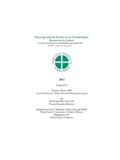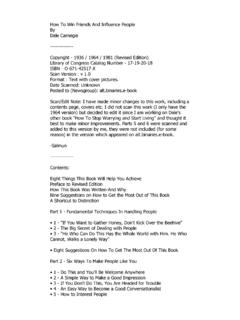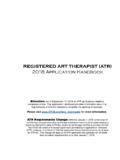Transcription of Gender and Poverty Reduction Malawi - United …
1 Gender and Poverty Reduction in Malawi By Naomi Ngwira Economist Tel:265 999489494 1. The past is prologue: Gender and development in historical perspective This paper looks at the nature and progress of planning and implementing engendered development in Malawi : it provides a cursory review of the gendered situation in key sectors and what can be done to accelerate progress. The odyssey of planning and implementing Gender and development programs has been a winding and tortuous one, but recalling it provides lessons for how to do Gender and development work going forward. After gaining political independence from Britain, the Government of Malawi (GoM) formulated the Statement of Development Polices: 1971 1986. The strategy made no mention of Gender or women s issues. So the earliest programs that dealt with women s issues were handed over from the colonial government, lodged in the ministries of agriculture, community development, and also education.
2 Farm home assistants, female community development assistants and teachers specializing in home economics were trained at Magomero community development training college, various Farm institutes and teacher training colleges. They taught needlecraft, and home care skills, cookery and nutrition the hallmark of which was teaching people to eat the three food groups. From 1986, for another ten years there was a hiatus in producing long term/medium term plans. In the early 1980 s the Women in Development movement started to influence the research and planning of extension in the Ministry of agriculture. The extension programs moved beyond reaching women with practical homemaking skills to empowering them with access to strategic resources and skills (Moser 1989). This led to activities to reach women farmers with credit and inputs. After the Nairobi UN Women s Conference in 1985, the Malawi government formed the National Commission for Women which spearheaded new programs.
3 The most successful of these was the Girls Attainment in Basic Literacy and Education. By the time of the Beijing conference women programs had more sophistication, even if only in rhetoric. A policy on Women in Development was prepared which was used to direct GoM efforts. After the Beijing conference a national Gender machinery was institutionalized, carrying varying nomenclature over the years. Government formulated a policy on Gender and the girl child became a key area of the policy. In 1998 Government published and launched Vision 2020 a long term perspective study of economic growth and development in Malawi . It was rather Gender blind even though women s issues were highlighted in some parts of the document. It did not bring out the role of men in attaining gendered development goals. This issue is important in areas of family planning, safe motherhood, HIV/AIDS prevention, and Gender based violence.
4 Also being a long term development document it did not have specific plans and targets as these were to be introduced in the medium term, and annual implementation plans. Because of this observed deficit, the Ministry of Gender began to speak more explicitly of the move from the WID approaches to Gender and development approaches The momentum set by the Beijing conference and the democratic dispensation led to the creation of NGOs focusing on Gender issues. The emphasis on women s strategic needs of economic and political empowerment was heightened. The most influential of the NGOs were dealing with micro finance, law reform, and domestic violence. Some research and reform of laws on family, wills and inheritance were strongly advocated for and ensued under the Law Commission. A bill was prepared though it is not yet enacted. A law on domestic violence has been enacted. More recently the Gender and Development Network has spearheaded reputable work on including women in political leadership.
5 In 2001 the GoM published the Poverty Reduction strategy (PRSP) 2001 4. Its aim was to make development planning and implementation more Poverty focused, as opposed to what was happening under the Structural adjustment programs that government had been implementing between 1986 and 2000. During this time the World Bank and the IMF put many countries, Malawi included, under receivership and direct supervision of development planning. The evaluations of what happened to growth and development during this period have been mostly negative. One important criticism was that the policies and programs that were focused on macroeconomic programming and economic liberalization did not contribute to Poverty Reduction . This was partly because they ignored the Gender roles and what happened on the home front following expenditure cutting programs, and poorly planned economic deregulation. PRSPs were supposed to refocus development efforts on Poverty Reduction even if the core principles of structural adjustment did not change in most countries.
6 The PRSPs were in fact used as a trigger for qualifying for IMF/World Bank funding and thereby also non humanitarian bilateral Aid. During the formulation stage of the PRSP specific efforts were made to include mainstream Gender (Ngwira et al, 2002). Most of the efforts were no fruitful as Gender was invisibilised or evaporated during the final stages of making the PRSP and also during implementation. So even where engendered programs were being implemented they were not being reported and monitored adequately. For all the political visibility and advocacy for Gender , there was little progress to implement the core strategic approach of the Beijing conference: mainstreaming . A new development strategy, the Malawi growth and development strategy (MGDS) was formulated in 2006 with the overriding philosophy of accelerating economic growth through infrastructure development as a means to sustainable Poverty Reduction .
7 The goal of the MGDS is to transform Malawi from being a consuming and importing country to a producing and exporting country. The MGDS prioritizes 10 areas and Gender is not among them. Gender has been included as a subtheme under the Social development theme, one of its 5 themes1. The MGDs states at p74 that Gender issues are an integral part of the overall national development agenda. Gender inequalities in accessing productive resources, development opportunities and decision making affect economic growth and development. Gender being a cross cutting issue of development concern must be mainstreamed in the national growth and development strategies. This is to address the existing Gender imbalances for Gender equality and sustainable socio economic development. The key areas of concern in Gender mainstreaming are education and training; 1 Sustainable Economic Growth; Social Protection, Infrastructure Development; Good Governance reproductive health; HIV and AIDS, food and nutrition security; natural resources and environmental; human rights; and economic empowerment.
8 The goal for this sub theme is to mainstream Gender in the national development process to enhance the participation of women and men, girls and boys for sustainable and equitable development. The strategies for achieving this are: Strengthen the institutional capacity for effective co ordination of Gender policy implementation; Affirmative action to increase women and children decision makers in high levels of the public and private sectors; Advocacy to include Gender equality provisions in the Malawi Constitution; and Break the cultural/traditional factors which create and perpetuate Gender inequalities. However there has been little success in bringing systemic treatment (mainstreaming) of Gender , in GoM planning and program implementation. A review done by the Sector Working Group on Gender in June 2010 observes that: Gender does not have sufficient presence within the Ministries at Central and district level.
9 While project oriented activities are being conducted in the area of Gender Based Violence and the 50/50 Campaign2, little is done to develop a broad ranging network and an advocacy campaign and an M&E system to ensure the capacity building and mainstreaming of Gender across all sectors. The present focal Gender point approach does not have a face at the political and decision making level (GoM, MGC&CD, 2010 p25). Much of the reason for this failure can be attributed to lack of will to move the Gender agenda forward especially at the top policy making and planning levels. This has much also to do with the cohort of the top policy makers that were brought up in the domestic science school of dealing with women s issues, and most of them (90% of the P4 positions and above) are men. There are also very weak incentives for formulating and reporting on, let alone achieving targets of, Gender responsive programs.
10 2. The state of Gender and Poverty in Malawi Because of this lack of or failure to mainstream Gender the results on Gender and Poverty are not satisfactory. Women still lag behind in many areas of development and men s contribution to changing the situation is not being fully harnessed. The main development areas where women s participation has greater Poverty Reduction returns are education, economy, health, decision making, social protection, human rights protection, and legal reform to support the other areas. It is possible to estimate the costs of implementing Gender blind development programs in these areas in terms of forgone economic growth (wealth creation) and Poverty Reduction . Semu et al, 2004, estimated, depending on sector of theme, that up to 2% economic growth is foregone due to implementing Gender unresponsive programs. The paper provides a review of the gendered situation in some of these areas.

















